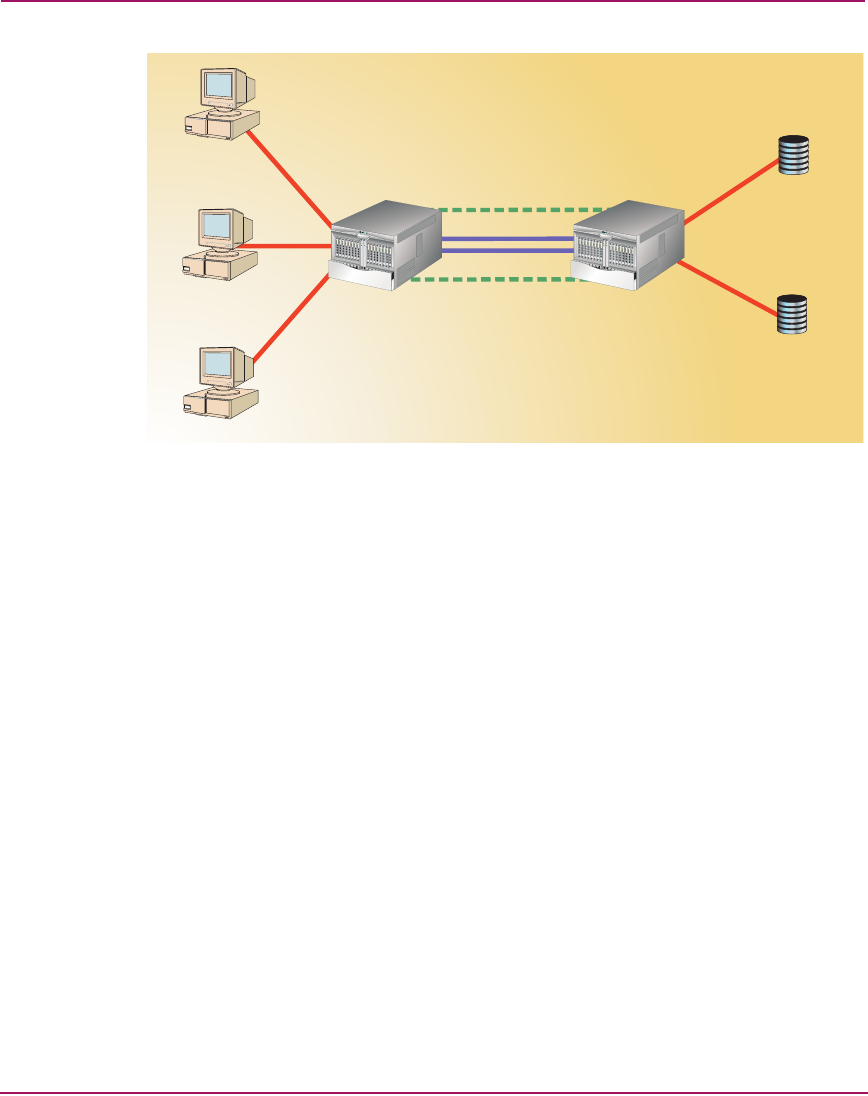FW V06.XX/HAFM SW V08.02.00 HP StorageWorks SAN High Availability Planning Guide (AA-RS2DD-TE, July 2004)
Table Of Contents
- SAN HA Planning Guide
- Contents
- About this Guide
- Introduction to HP Fibre Channel Products
- Product Management
- Planning Considerations for Fibre Channel Topologies
- Fibre Channel Topologies
- Planning for Point-to-Point Connectivity
- Characteristics of Arbitrated Loop Operation
- Planning for Private Arbitrated Loop Connectivity
- Planning for Fabric-Attached Loop Connectivity
- Planning for Multi-Switch Fabric Support
- Fabric Topologies
- Planning a Fibre Channel Fabric Topology
- Fabric Topology Design Considerations
- FICON Cascading
- Physical Planning Considerations
- Port Connectivity and Fiber-Optic Cabling
- HAFM Appliance, LAN, and Remote Access Support
- Inband Management Access (Optional)
- Security Provisions
- Optional Features
- Configuration Planning Tasks
- Task 1: Prepare a Site Plan
- Task 2: Plan Fibre Channel Cable Routing
- Task 3: Consider Interoperability with Fabric Elements and End Devices
- Task 4: Plan Console Management Support
- Task 5: Plan Ethernet Access
- Task 6: Plan Network Addresses
- Task 7: Plan SNMP Support (Optional)
- Task 8: Plan E-Mail Notification (Optional)
- Task 9: Establish Product and HAFM Appliance Security Measures
- Task 10: Plan Phone Connections
- Task 11: Diagram the Planned Configuration
- Task 12: Assign Port Names and Nicknames
- Task 13: Complete the Planning Worksheet
- Task 14: Plan AC Power
- Task 15: Plan a Multi-Switch Fabric (Optional)
- Task 16: Plan Zone Sets for Multiple Products (Optional)
- Index

Physical Planning Considerations
168 SAN High Availability Planning Guide
Figure 61: Open Trunking configuration
The figure illustrates two Director 2/64 directors connected by two ISLs. Three
servers use the ISLs to communicate with two storage devices. Without trunking,
servers 1 through 3 route Fibre Channel traffic to director B without regard to any
data rates. A possible scenario is that servers 1 and 2 route high data rate traffic
through ISL 1 to storage device 1 (ISL oversubscription) and server 3 routes low
data rate traffic through ISL 2 to storage device 2 (ISL undersubscription).
Note that preferred path configurations are more restrictive than and take
precedence over Open Trunking. Even if Open Trunking is enabled, no attempt is
made to reroute traffic away from a preferred path, even if the path is congested or
BB_Credit starved.
Full Volatility
Full volatility is a feature (available on directors and switches with firmware
version 6.0 and later) that supports military, classified, or other high-security
environments that require that Fibre Channel data not be retained by the director
or switch after power-off or failure.
When a director or switch (without the full-volatility feature installed) powers off
or fails, a dump file is written to non-volatile random-access memory (NV-RAM).
This dump file retains the last 30 Fibre Channel frames transmitted from the
embedded port and the last four frames transmitted to the embedded port.
Server 1
ISL 1
Storage 1
Server 2
Server 3
T
M
ISL 2
Storage 2
Director A Director B
T
M
Trunk
ISL 1
ISL 2










